What are the three domains of life? They’re eukaryotes, bacteria, and archaea. Two of these branches, bacteria, and archaea, are prokaryotes.
Prokaryotes are organisms with prokaryotic cells, and eukaryotes have eukaryotic cells. Plants, animals, and fungi wouldn’t be here without the evolution of eukaryotic cells. Meanwhile, prokaryotes help make the world livable.
When it comes to prokaryotes vs. eukaryotes, which are stronger? Also, what are the top differences between these microbial life forms? Follow along to find out.
Overview: Prokaryotes vs. Eukaryotes

Prokaryotic cells make up all bacteria and archaea, while eukaryotic cells make up all animals, plants, and fungi.
©VectorMine/Shutterstock.com
Prokaryotes vs. eukaryotes; what do you need to know?
Three life forms emerged during the Proterozoic Eon: eukaryotes, bacteria, and archaea. Bacteria and archaea are prokaryotic cells. They lack a nucleus or plasma-bound organelles.
Eukaryotes have eukaryotic cells which can develop new characteristics. These lively cells have a nucleus and organelles. Furthermore, all plants and animals have eukaryotic cells. And over the last 2 billion years, eukaryotic cells have undergone some major changes.
What Is a Cell?
Let’s start with the basics to understand the differences between prokaryotes vs. eukaryotes. For instance, what is a cell anyways?
Cells are the building blocks of life. We require them to keep organisms alive and healthy. All living things have cells. These small units have the tools they need to keep the organism alive.
In a way, cells are a lot like a bag of jello. They’re bound within a container (the cell wall) and have a jello-y substance (plasma). Sometimes within the jello of the cell, you’ll find organelles. This is the case for eukaryotic cells, like the ones in your body.
Organelles refer to the different parts of the cell and their different jobs. The nucleus and mitochondria are both organelles but with entirely different missions.
Cell size and shape vary depending on the organism. There are long, thin cells, oval cells, round ones, and more. Sometimes they work together to grow organs and tissue, like a heart or lungs.
What Is a Nucleus?
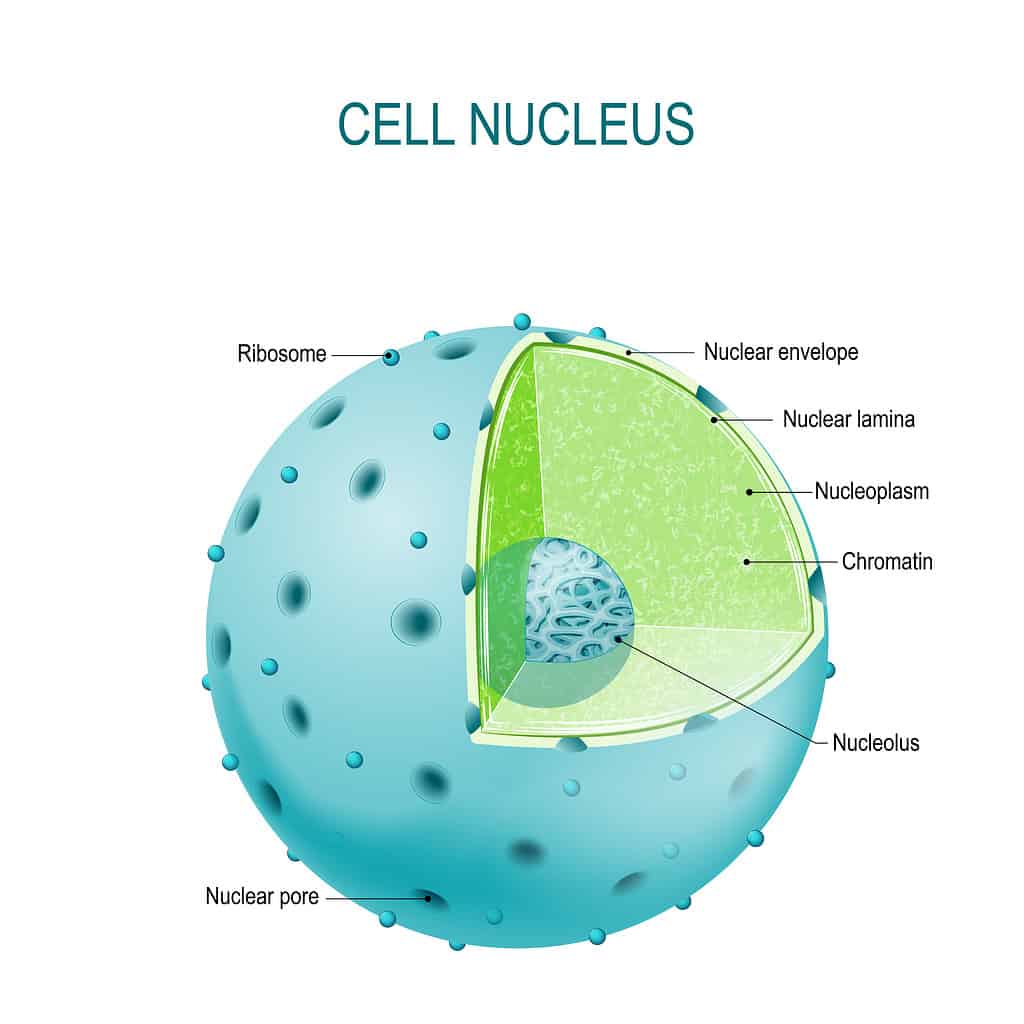
The cells of eukaryotes have a nucleus, which contains most of the cell’s DNA.
©Designua/Shutterstock.com
Eukaryotic cells have a membrane-bound structure called a nucleus. The nucleus contains most of the cell’s genetic material or DNA. Its controls how genes make things.
Here’s what the nucleus is all about:
- Cells have a part called the nucleus that holds genetic material.
- The genetic material is in structures called chromosomes.
- Chromosomes are DNA and proteins.
- A double membrane surrounds the nucleus called the nuclear envelope.
- There are tiny holes called nuclear pores in the nuclear envelope.
The exact size of the nucleus varies based on cell type. Specific cells, like red blood cells, don’t have any nucleus. Thanks to the nuclear pores, molecules can enter and exit the nucleus.
Prokaryotes
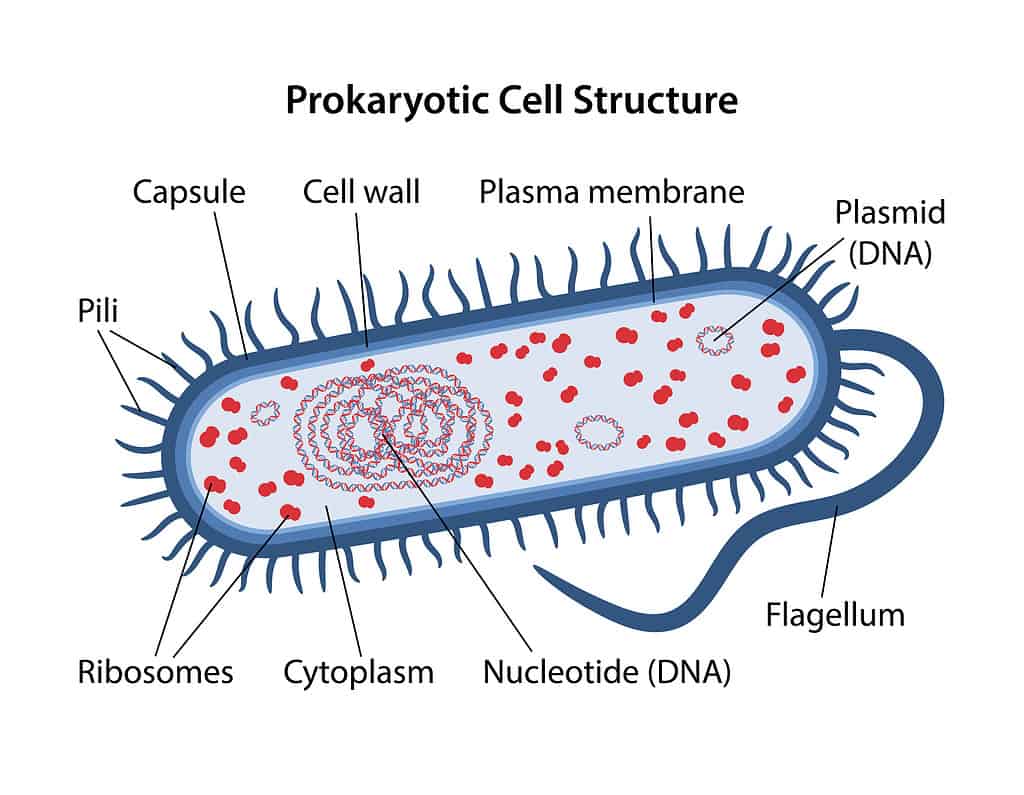
Lacking a nucleus and membrane-bound organelles, prokaryotic cells are different from eukaryotic cells in key ways.
©Olga Bolbot/Shutterstock.com
A prokaryotic cell lacks a nucleus and other membrane-bound organelles. The genetic material in a prokaryotic cell is in the form of a circular strand of DNA that is not enclosed in a nucleus.
Prokaryotic cells are much smaller and simpler in structure than eukaryotic cells. They’re a diverse group of microorganisms that have been present on Earth for billions of years.
Here are a few more facts about prokaryotes:
- Prokaryotes (bacteria) recycle nutrients by decomposing dead organisms
- Prokaryotic DNA is in a nucleoid without a membrane or true nucleus
- Prokaryotes use energy methods (photosynthesis, respiration, etc.)
Another exciting thing about these cells is how quickly they reproduce. Prokaryotes reproduce every 24 hours using binary fission, a type of asexual reproduction. The parent cell divides to create two brand-new cells.
Eukaryotes
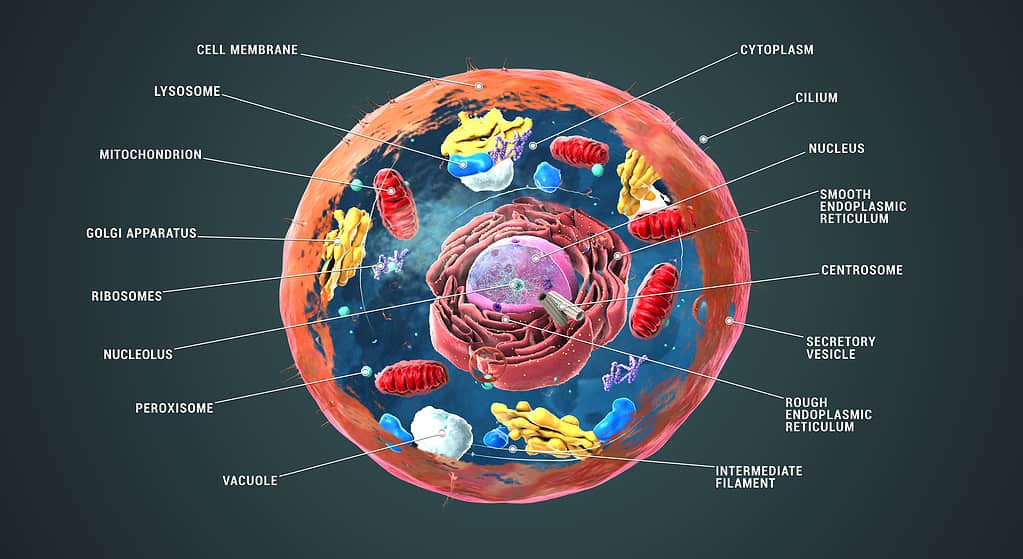
The organelles of a eukaryotic cell perform specific functions within the cell.
©Christoph Burgstedt/Shutterstock.com
Eukaryotic cells have a nucleus and multiple organelles. These plasma-bound organelles all carry out specific functions. For instance, the endoplasmic reticulum helps with protein synthesis. And the mitochondria create energy for the cell to survive.
Here’s a brief overview of eukaryotes:
- Eukaryotic cells have organelles with specific functions.
- Cell organelles include the endoplasmic reticulum, Golgi apparatus, and mitochondria.
- The endoplasmic reticulum makes proteins.
- The Golgi apparatus modifies and packages proteins.
- Mitochondria produce cell energy.
- Eukaryotic cells can have different organelle proportions.
Eukaryotic cells have similar jobs but look very different. The organelle proportions vary inside a eukaryotic cell, with their size dependent on function. For instance, most eukaryotic cells have mitochondria, but the mitochondria size, number, and shape can vary. These variations are evident in different cell types and occur within the chondroma. The chondroma is all mitochondria within a cell. And the mitochondria are responsible for creating energy to fuel the cell.
Prokaryotic vs. Eukaryotic Cell: Key Differences
Prokaryotic cells and eukaryotic cells differ in a few ways. Here’s a brief breakdown of the differences between prokaryotes vs. eukaryotes:
- Prokaryotic cells don’t have mitochondria or organelles
- Eukaryotic cells have mitochondria and other organelles
- Prokaryotic cells don’t have a nucleus
- Eukaryotic cells have a nucleus
- Prokaryotic cells have circular DNA
- Eukaryotic cells have linear DNA
- Eukaryotic cells are larger and more complex than prokaryotic cells
- Eukaryotic cells have membrane-bound organelles and a cytoskeleton.
- Prokaryotic cells reproduce asexually through binary fission,
- Eukaryotic cells can reproduce sexually and asexually.
- Eukaryotic cells have a more comprehensive range of specialized organelles.
- Eukaryotic cells have a more complex membrane transport system
Remember how the mitochondria help create energy for the organism to live? Well, prokaryotic cells lack mitochondria and organelles enclosed in plasma membranes. But eukaryotic cells have both. Additionally, eukaryotic cells have multiple molecules of linear DNA. In contrast, prokaryotic cells have circular strands of DNA.
Without mitochondria, how do prokaryotic cells function? The prokaryotic cells’ critical function is to help recycle nutrients by decomposing dead organisms. For example, bacteria, a prokaryotic cell type, are important decomposers in many ecosystems.
Prokaryotic vs. Eukaryotic Cell: Similarities
Some similarities exist between prokaryotes and eukaryotes, despite their significant differences. Here’s a breakdown of the characteristics they share:
- Both cell types have ribosomes for protein synthesis
- Both cell types have genetic material (DNA) that determines traits
- Cytoplasm is present in both cell types
- Enzymes and molecules needed for metabolic processes are present in both cell types’ cytoplasm
- Both cell types have plasma membranes that separate internal and external environments
- The plasma membrane in both cell types is a lipid bilayer with proteins and other molecules
- The plasma membrane regulates the movement of molecules
The plasma maintains the cell’s internal environment - Ribosomes float freely or attach to the endoplasmic reticulum in both cell types
- Both cell types use DNA as their primary molecule for genetic information
- Both cell types use ATP as a source of energy for cellular processes
Both types of cells contain ribosomes, which are structures that help to synthesize proteins. Ribosomes are both RNA and protein; they are essential for the functioning of the cell. In both types of cells, ribosomes float freely in the cytoplasm or are attached to the endoplasmic reticulum.
Another similarity is the presence of genetic material or DNA. DNA contains genetic information that determines the characteristics and traits of an organism.
The DNA is in a nucleoid region in prokaryotic cells, not enclosed by a membrane. In eukaryotic cells, the DNA is in the nucleus, separated from the rest of the cell by a membrane.
Both Cell Types Have Cytoplasm and Plasma Membranes
Both prokaryotic and eukaryotic cells have cytoplasm, a type of cell fluid outside the nucleus. Cytoplasm is a gel-like substance. The plasma fills the cell to maintain its environment. It also contains various structures and molecules necessary for the functioning of the cell.
In both types of cells, the cytoplasm contains enzymes and other molecules. These molecules assist with the metabolic processes. They also help create structures like the cytoskeleton.
Finally, both prokaryotic and eukaryotic cells have plasma membranes. The plasma membrane is a thin, flexible barrier. It surrounds the cell and separates its internal and external environment. It’s a lipid bilayer that contains proteins and other molecules. The plasma membrane is critical in maintaining the cell’s internal environment. It’s responsible for the movement of molecules in and out of the cell.
Examples of Prokaryotic Cells
Now, let’s review a few more examples of what prokaryotic cells are all about. There are two types of prokaryotes: eubacteria and archaea. For instance, there are bacteria, archaea, and cyanobacteria.
Cyanobacteria

Using photosynthesis, cyanobacteria can make food using sunlight, so long as they have wet soil or water. Cyanobacteria’s common name is blue-green algae.
©VectorMine/Shutterstock.com
Cyanobacteria is a type of prokaryotic cell. This tiny, alive bacteria can make food using sunlight (photosynthesis). To do this, though, they need wet soil or water. Examples of cyanobacteria are Oscillatoria, Nostoc, and Spirulina.
Bacteria
What are bacteria exactly? Bacteria are itty bitty single-celled organisms. They don’t have a nucleus or other compartments in their cells. Their DNA is in the cytoplasm. Bacteria can reproduce by fission or spores and live in many different places.
Archaea
Archaea are also unicellular and are different from bacteria and eukaryotes. They make enzymes for essential processes in their cells. This prokaryote can survive in extreme environments. They are thermo-files, which means they’re heat-loving.
More About Archaea: Prokaryotes
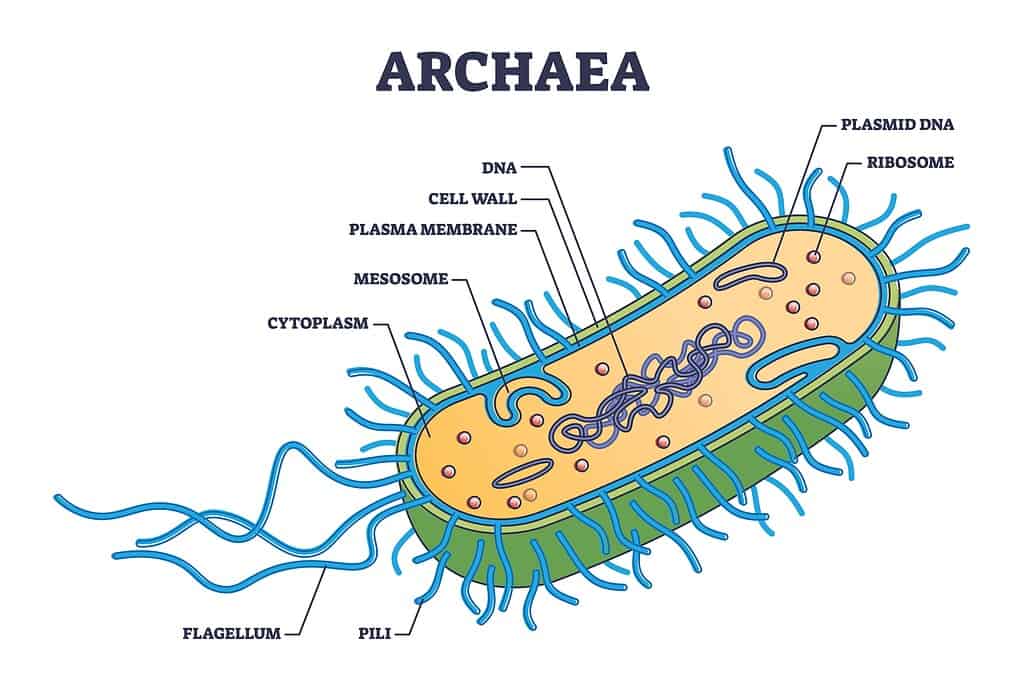
Breaking down organic matter and producing methane gas, archaea play a vital role in the ecosystem.
©VectorMine/Shutterstock.com
Archaea, a type of prokaryote, also play important roles in the ecosystem. They break down organic matter and produce methane gas.
Archaea are similar to bacteria but have unique features that set them apart. Like bacteria, they lack a nuclear membrane, and their genetic material rests in a single circular chromosome. However, unlike bacteria, they also have unique rDNA or recombinant DNA.
Archaea’s cell membranes are ester-linked lipids. Esterification attaches the carbonyl group using alcohol and releases a water molecule. The ester-linkage makes archaea cells more stable and able to survive in extreme environments.
Archaea live in extreme environments like hot springs, deep-sea hydrothermal vents, and salt flats. Some archaea have unusual metabolic processes, such as using hydrogen gas to produce energy.
Crenarchaeota is a type of Archaea, a group of tiny, single-celled organisms. Scientists study them to learn how life can survive in extreme places. These thermo-files like to live in extreme places like hot springs and hydrothermal vents.
Crenarchaeota can handle scorching temperatures up to 212°F! They help break down sulfur and keep the environment in balance. There are many different types of Crenarchaeota throughout the world.
More About Bacteria: Prokaryotes
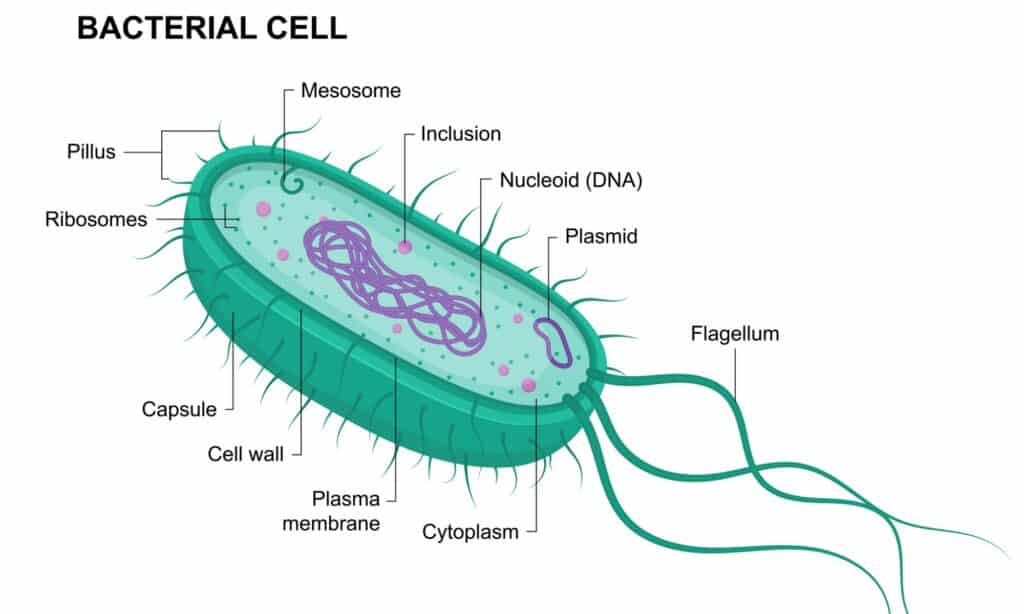
The first prokaryotes discovered were bacteria, after microbiologist Antonie van Leeuwenhoek wrote of them in a 17th-century paper.
©iStock.com/Vitalii Dumma
Bacteria are tiny organisms that were the first prokaryotes discovered in 1676. They have no nucleus, and their genetic material rests in a single circular chromosome. Their cell membranes comprise diacylglycerol diester lipids that help protect them. They play essential roles in the ecosystem and can harm and benefit humans.
Bacteria have ribosomes that are smaller in size and have unique bacterial rRNA that helps identify them from other organisms. These ribosomes help the bacteria make the proteins they need to survive.
Bacteria can thrive in many places, such as soil, water, and other living things. They are an essential part of the ecosystem. Bacteria break down dead organic matter. They also convert atmospheric nitrogen into forms that other organisms can use.
While some bacteria can cause disease, most are harmless or beneficial to humans. Beneficial bacteria can help with digestion, produce vitamins, and even fight harmful bacteria. They are used in many industries, including food production and medicine.
An example of a good bacteria would be lactobacillus, found in the human mouth, vagina, and gut. This bacteria is a probiotic that can help prevent harmful bacteria from colonizing your intestines.
Examples of Eukaryotic Cells
Animal and plant cells are both eukaryotic. For instance, your contains various blood cells and neurons. Both of these are types of eukaryotic cells.
Plant Cells and Animal Cells
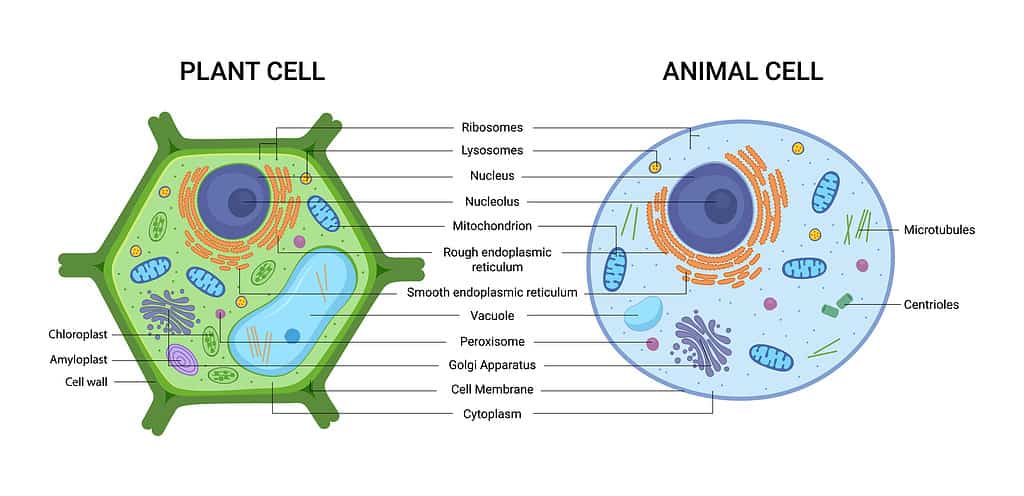
All living things are made up of cells. Pictured is an illustration comparing animal cells with plant cells, both of which are eukaryote cells.
©LDarin/Shutterstock.com
Plant cells have a cell wall, a large vacuole, and chloroplasts. In comparison, animal cells have only a cellular membrane, small vacuoles, and no chloroplasts.
Animal cells diverge from a singular stem cell into specialized cells. These specialized cells have different shapes and proportions of organelles. Size depends on the function.
For instance, nerve cells have a long thin axon. The slender proportion helps the nerves quickly transmit information. These cells can survive many years as permanent cells. The endoplasmic reticulum plays a big role in stimulating the nerves.
Eukaryotic Cells Are Made Possible by Endosymbiosis
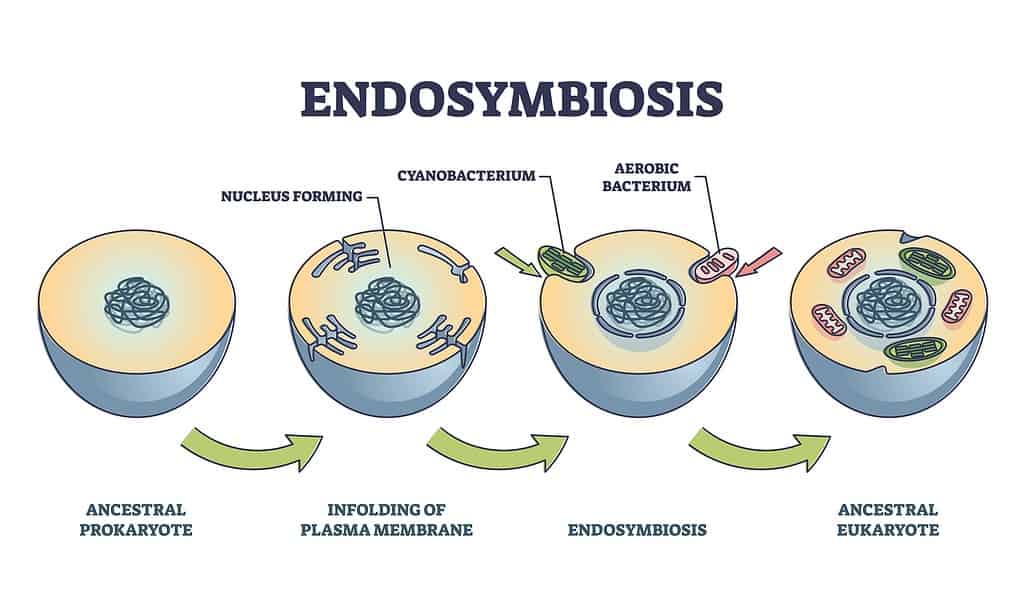
A process called endosymbiosis is the means by which eukaryotic cells exist.
©VectorMine/Shutterstock.com
Eukaryotic cells wouldn’t exist if it weren’t for endosymbiosis. Endosymbiosis helped eukaryotic cells evolve and allowed for more complex organisms to form.
Endosymbiosis is a symbiotic relationship where one organism relies on another by living inside it. In the case of eukaryotic cells, it’s believed that they evolved from the internalization of prokaryotes.
How does endosymbiosis happen between eukaryotes and prokaryotes? Here’s a breakdown:
- The prokaryotic cell becomes swallowed by another cell and begins living inside it.
- The two cells became mutually dependent on each other; it’s a symbiotic relationship.
- Both cells form a new cell with both characteristics.
The internalized prokaryotes eventually evolve into specialized organelles. They can evolve into photosynthesis-producing chloroplasts or energy-producing mitochondria.
Final Thoughts on Prokaryotes vs. Eukaryotes
Now you know the ins and outs of what prokaryotes vs. eukaryotes are all about. Their stories began billions of years ago and have helped create the world around you.
Bacteria and archaea, the prokaryotic cells, are simple cells. They don’t have a nucleus or membrane-bound structures. Eukaryotes are more complex cells with a nucleus and specialized structures. Plants, animals, and fungi are all eukaryotic cells with different structures depending on their job.
Prokaryotic cells are ancient, dating back over 3 billion years! These cells don’t have membrane-bound structures or mitochondria. However, they can break down dead things to recycle nutrients.
Eukaryotic cells are more complex and can develop new characteristics. They also have different structures for specific jobs, like making proteins or producing energy. Eukaryotic cells are important because they allow more complex life forms to develop. Without them, we wouldn’t exist!
The photo featured at the top of this post is © Vladra14/Shutterstock.com
Thank you for reading! Have some feedback for us? Contact the AZ Animals editorial team.






